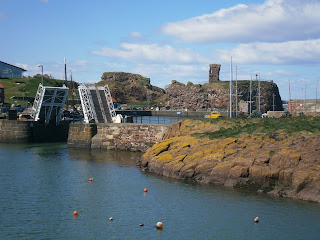 of a coal wharf or hirst. One of the more impressive features of Cromwell Harbour is the Fishermen's Monument or Barometer. Dedicated to the local fishermen for their invaluable contribution to the wealth of the town, it was erected in 1856 by a kindly local benefactor.
of a coal wharf or hirst. One of the more impressive features of Cromwell Harbour is the Fishermen's Monument or Barometer. Dedicated to the local fishermen for their invaluable contribution to the wealth of the town, it was erected in 1856 by a kindly local benefactor.
 For centuries fishing was one of Dunbar's main industries. Every year hundreds of fishing boats would come for the summer herring fishing off the Dunbar coast. Catches were gutted and packed in barrels layered with brine, and shipped off to Ireland, Europe and the West Indies. Throughout the winter months the boats fished for white fish such as cod and whiting and shellfish including crabs and lobsters.
For centuries fishing was one of Dunbar's main industries. Every year hundreds of fishing boats would come for the summer herring fishing off the Dunbar coast. Catches were gutted and packed in barrels layered with brine, and shipped off to Ireland, Europe and the West Indies. Throughout the winter months the boats fished for white fish such as cod and whiting and shellfish including crabs and lobsters.When herring fishing took off with a vengeance in the early part of the19th century, the old Cromwell Harbour was no longer big enough to cope. It was time for a new harbour. To assist them in this venture, Dunbar Town Council received £4,500 from the Fishery Board on the understanding that they matched this sum. Now picture the scene ...... On a stormy day in October, members of the Council and the appointed chief engineer met with fishermen on the castle rock. With the wind blowing through their hair and rain chilling them to the very bone, they put their heads together and discussed the most suitable place for their new harbour entrance. Only fifteen years after the opening of this new harbour, designed by David Stevenson, members of the Council were again lobbying Parliament for more funding. A storm had caused serious damage to the north wall.
By the end of the 19th century changes had taken place, potatoes replacing salt and herring as the main export from Dunbar Harbour. Most of the catch was now carried to home markets by the railway. And while local fishermen still used smaller open boats during the winter, larger decked fifies were now a common sight. Earlier driftnet fishing had been replaced, not without more than a little controversy, by trawling. Boats were propelled by steam power which in turn was replaced by engines at the turn of the 20th century.
Building the new harbour, the Victoria Harbour, had not been without its problems. A sea wall was constructed from Lammer Island to the ruined castle. A bridge was erected to allow access to the Battery, which had a small hospital within its grounds. And more spectacularly, a causeway was blasted through the old castle rock to allow access into the new harbour. Lifeboat stations came, went, and came again, and today fishing still plays a major part in the economy of Dunbar. The harbours are lovely places to wander around when the weather is fine, not so good when the weather draws in. Two harbours, a castle and the sea - this is as good as chocolate!!


No comments:
Post a Comment